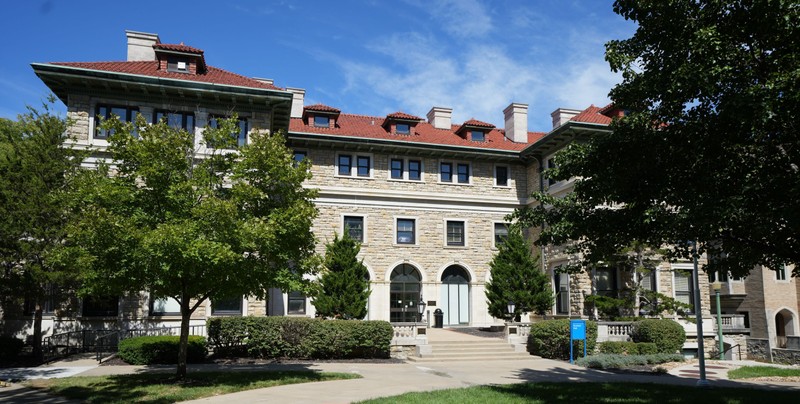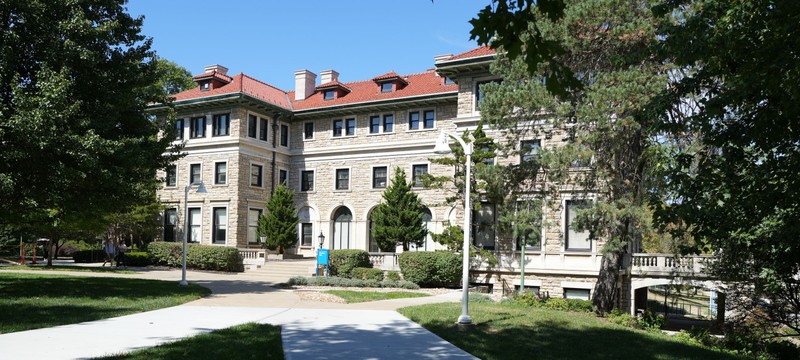Scofield Hall
Introduction
Text-to-speech Audio
Constructed from 1912 to 1914 for industrialist and local newspaper publisher Walter S. Dickey, this stately mansion became the first building of the University of Kansas City after philanthropist William Volker acquired the property and donated it to the new university in 1931. Volker was one of the strongest advocates for the new university, and with his help, classes started in the fall of 1933 despite the financial turmoil wrought by the Great Depression. The building was later renamed in honor of former chancellor Carleton Scofield, who oversaw the transition from a private university to a member of the University of Missouri system. Dr. Scofield became the last president of the University of Kansas City in 1961, and following the successful merger, he retired as chancellor of the University of Missouri-Kansas City in 1965.
Images
Kansas City philanthropist William Volker purchased this mansion and the surrounding acreage to support efforts by city boosters to build a university at this location.

The building was later renamed to recognize the contributions of Carleton Scofield who led the transition from private to public university

Walter Dickey

Photo of the Dickey Mansion, circa 1914

The Dickey mansion's carriage house, removed in 2016, served the university over the years as a gymnasium, theater, campus newspaper, police station, maintenance building and engineering lab.

The Dickey family greenhouse, removed in 1968, served the university over the years a science lab, daycare center, student union, campus bookstore and the bursar's office.

Opening Convocation of the University of Kansas City Oct 1, 1933.

English Class in the Administration Building circa 1933.

Dr. Carleton Scofield

President Truman speaks at the university in 1945

Plaque commemorating President Truman speech. Back patio of Scofield Hall

KCUR tower under construction at the southwest corner of Scofield hall in 1957

Backstory and Context
Text-to-speech Audio
Walter S. Dickey migrated to Kansas City from Canada in 1885. A few years later, he started the W.S. Dickey Clay Manufacturing Company, which made ceramic pipes out of burnt clay. At first, the business sold these pipes to farmers to drain their land with. However, as technology grew and developed, W.S. Dickey began selling to phone companies as early phone lines were put down. In addition, as more municipalities in the area developed their own sewage systems, the company began to sell to them, too, finding great success in doing so. In 1912, after his clay company proved successful, Dickey began construction on the Dickey Mansion at 51st and Rockhill Roads in Kansas City, Missouri. It took two years to complete. The marble for the home was imported from Italy. However, the limestone was quarried on site and the resultant hole at the corner of 51st and Rockhill was turned into a duck pond. A natural gas well on the property supplied the home.
Dickey's other business ventures, including newspapers, failed and his investments crashed during the 1920s, putting him millions of dollars in debt. His financial troubles necessitated that he mortgage his home and property, in which he had $750,000 invested, for $75,000. After his death in January, 1931, Kansas City philanthropist William Volker approached Dickey's heirs with an offer to pay off the mortgage so that he could donate the home and property to the planned University of Kansas City. A year earlier, Volker had purchased the vacant 40 acres immediately to the north to serve as a campus for the university. Dickey's heirs agreed and the home became the first building of the University of Kansas City, called the Administration Building. The home was remodeled to suit the needs of the university, which opened on October 2, 1933. The living room was turned into a library. 2nd floor bedrooms became classrooms and offices. A $10,000 gift from neighboring Menorah Hospital helped the university to turn the kitchen into a science laboratory. A large greenhouse and a carriage house were also part of the Dickey property. The greenhouse was split in half with a biology lab on one side and a chemistry lab on the other. The home's former carriage house became a small gymnasium. The was enough room for a one-basket basketball court, some weights and a boxing ring.
As the university grew and the university built other facilities including the Science Building in 1935, the Library in 1936 and the Liberal Arts building in1937, the university was able to finally provide proper office space for its president and administrators within the Administration Building. The Kansas City School of Law, which merged with the university in 1938, occupied the 2nd floor until 1950. In 1953, the 2nd floor became home to the new School of Business and Public Administration until the purchase of Oxford Hall in 1965. Numerous other university departments were located in the building over the years, including the university's KCUR radio station, which was created there in 1957. The foundation for its radio tower is still visible at the building's southwest corner.
The back patio of the Administration Building served for decades as the university's stage. This was the location of convocation and graduation each year. This is where the President Harry Truman spoke in 1945 and the university gave honorary doctorates to the President of Mexico, Miguel Aleman in 1947 and the Prime Minister of Pakistan Liaquat Khan in 1950. Bronze plaques mounted on the patio memorialize these events.
In 1976, the building was renamed Scofield Hall to honor Carleton Scofield, the president of the University of Kansas City, who helped orchestrate the school's merger with the University of Missouri System. Scofield has been a professional psychologist, before entering academy at the University of Buffalo. He was recruited as an intelligence agent during the Second World War and help organize psychological warfare operations against the Japanese in the Pacific Theater. He was recruited by UKC President Richard Drake to become the university's vice president in 1957. When President Drake resigned in 1961, the trustees named Scofield acting president and charged him with trying to help save the financially troubled institution. By convincing the university's trustees to merge with the University of Missouri System in 1963, he helped save it from bankruptcy and also provided the new UMKC with the support it needed to realize its potential. He retired in 1965 as the last President of the University of Kansas City and the first Chancellor of the University of Missouri-Kansas City.
Today Scofield Hall is home to UMKC's School of Humanities and Social Sciences. The dean's office is the former university president's office. This space was originally the home's breakfast room. The Department of Foreign Languages and Literature occupies the second floor. The rest of building is occupied by various university programs including advising offices.
Sources
Scofield, Carleton. A History of the University of Kansas City: Prologue to a Public Urban University. Kansas City, MO. Lowell Press, 1976.
Wolff, Christopher. A Pearl of Great Value: The History of UMKC, Kansas City’s University. Kansas City, Missouri. UMKC Alumni Association, 2016.
Crawford, Tonya. "A Foundation Made of Stone," Old School: The UMKC University Archives Blog. September 15th, 2015. Accessed July 27th, 2022. https://kcroonews.com/scofield-hall-is-a-former-mansion/.
"UMKC's first chancellor, Carleton F. Scofield, dies." (Kansas City Star) March 15th, 1990.
Photo by David Trowbridge
Photo by David Trowbridge
Creel, George. The Men Who are Making Kansas City. Hudson-Kimberly Publishing. 1902
Chris Wolff, UMKC Historian, photo collection
Chris Wolff, UMKC Historian collection
UMKC, University Archives photo k_1_151_9_00513
UMKC, University Archives photo k-0k00k9-00079
UMKC, University Archives photo
UMKC, University Archives photo
Chris Wolff, UMKC Historian collection
UMKC, University Archives photo k_1_231_9-00122
